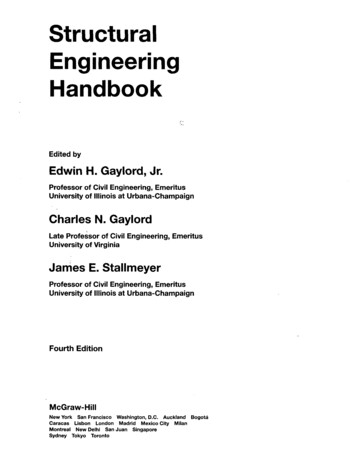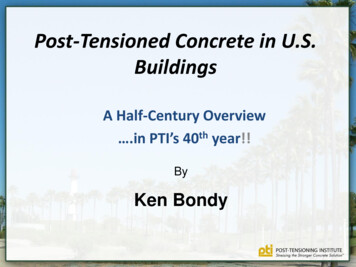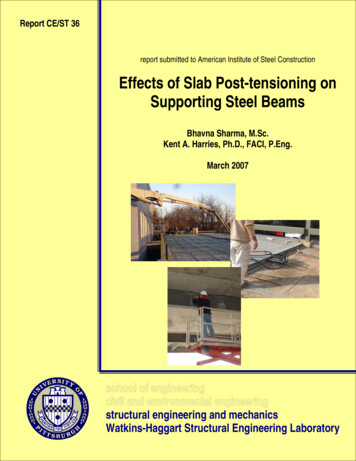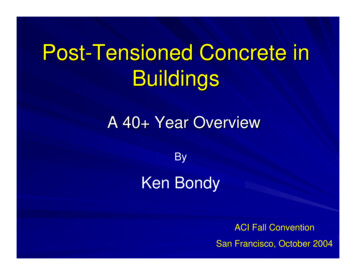
Transcription
AN OVERVIEW OF POST-TENSIONINGBySENG TONG NGANNUniversity of CincinnatiApril 2019Page 1 of 7
ABSTRACTConcrete is a mixture that is used worldwide in structural engineering applications. It isdocumented that concrete performs well in compression and weakly in tension.1 Since steelperforms well in tension, steel is added to concrete to resist a tension force, and this process iscalled a reinforced concrete. There is also another material that can be used in concrete towithstand the tension force, and it is a pre-tensioning or post-tensioning element. This practice iscalled pre-tensioning or post-tensioning system. These two systems behave differently. Thisarticle will discuss only about the post-tensioning system including fundamentals and types ofpost-tensioning, construction process, and advantages and disadvantages of post-tensioning.FUNDAMENTALS OF POST-TENSIONINGAccording to the Post-Tensioning Institute (PTI), post-tensioning (PT) is a method ofconcrete reinforcement in which high strength steel tendons are tensioned after the concrete isplaced in order to induce a compressive force in a member where there is a tension force.2 Asshown in figure 1, when a beam is loaded, a tension force is created at the bottom portion thatcauses the beam to fail in bending. If a PT tendon is installed and tensioned at the bottom portionof the member, a compressive force will be induced at the bottom of the beam that counteractsthe tension force. Therefore, the bending stress is reduced at the bottom part of the beam. As aresult, it is good to draw a moment diagram to the tensile face of a concrete beam. Then, thetendon just follows the drape of the moment diagram (figure 2).Figure 1. Loaded Beam with Tendon 2 (left image)Figure 2. Drape of Tendon and Moment Diagram 3 (right image)A further concept of PT design is shown in figure 3 & 4. A compressive stress is inducedat the top part, and a tension stress is induced at the bottom part due to the force F (figure 4a). Asa tendon is tensioned, a compressive stress is applied on the beam (figure 4b). Due to theeccentricity of the tendon location from the centroid of the beam, there will be a compressivestress at the bottom part and a tension stress at the top part of the beam (figure 4c). When all thestresses are combined, a high compressive stress is created at the top part, and a very low or notension stress exists at the bottom part of the beam (figure 4d). Since concrete performs well incompression, the beam will not fail.Page 2 of 7
Figure 3. A Beam with a Force and PT Tendon 2Figure 4. Stress Distribution of the Beam 2TYPES OF POST-TENSIONINGAccording to the PTI, there are two types of post-tensioning system which are unbondedand bonded post-tensioning.2 They are distinguished by materials, equipment, and constructionprocess.For the unbonded post-tensioning, the tendon is prevented from bonding to the concreteand is permanently free to move relatively with the concrete. A complete assembly of a posttensioning element consists of anchorages, a prestressing steel, a sheathing, and encapsulationaccessories (figure 5). A coated strand contains six high strength wires that are wounded arounda center wire conforming to ASTM A416/A416M. This is typically called the seven-wire strand.The wires are enclosed in a plastic sheathing with corrosion inhibiting grease (figure 6). Thesheathing is made of high-density polyethylene or polypropylene. It provides corrosionprotection and prevents any damage or moisture from getting into the wires. The grease staysbetween the plastic sheathing and wires. It increases the corrosion protection and reduces frictionbetween wires and sheathing.Moreover, the encapsulation accessories consist of grease cap, anchor plate or coatedanchor, pocket former, and wedge. The anchor plate prevents water infiltration and corrosion.The steel wedge is responsible for locking the wires after stressing the tendon; therefore, thetendon remains tight.Page 3 of 7
Figure 5. Parts of Unbonded PT System 4Figure 6. A Section of a Single Strand Tendon 2On the other hand, for the bonded post-tensioning, the tendon is bonded to the concreteand is permanently prevented from moving relatively with the concrete. According to the PTI,there are two types of systems used in the bonded post-tensioning. They are high capacitymultistrand system and flat system.2 The high capacity multistrand system is used in civilstructures and transfer beams or slab construction. The flat system is used more in thin concreteelements and slab construction. As shown in figure 7, both of them consist of the same type ofcomponents but in a different shape which is either round or rectangular. Those components arebare strands, anchorage assembly, corrugated duct, wedge, and grout accessories.Figure 7. High Capacity Multistrand System (left) and Flat System (right) 4Page 4 of 7
CONSTRUCTION PROCESSThe unbonded and bonded post-tensioning share a similar construction procedure. In theprocess of constructing the unbonded post-tensioning system, the tendon must be initially cut orprovided with a right length based on designs. Each tendon always has a dead and a live end. Thedead end has an anchor plate, a wedge, a lockable sleeve, and a grease cap. The live end initiallyhas an anchor plate, a lockable sleeve, and a pocket former. The tendon is installed with all thereinforcements before the concrete pour. Once the concrete has been placed and cured forapproximately 3 days, the tendon can be stressed at the live end by unbonded PT stressingequipment such as single strand stressing jack, stressing pump, and gauge. Before stressing thetendon, the pocket former needs to be removed, and the required strength of concrete must besatisfied. Next, a wedge needs to be inserted, and the tendon will be stressed to a certain load.Finally, any excess tendon will be cut, and any hole will be grouted and sealed.Figure 8. Tendon in Concrete (left) and Tendon Hole (right) 5,6The bonded post-tensioning doesn’t differ much from the unbonded post-tensioning. Forthe bonded PT system, a certain number of bare strands, that is required based on designs, isplaced in one duct. Then, all the steps remain the same except the final step. Once the tendonshave been stressed, and the holes have been sealed, grout will be inserted into the duct throughthe grout tube until the duct is full. Finally, the grout tube will be closed and sealed as well.Figure 9. Bonded Post-Tensioning with Grout Tubes 7ADVANTAGES AND DISADVANTAGES OF POST-TENSIONINGThere are many reasons why post-tensioning system is implemented in the concreteindustry and structural elements. According to the PTI and ConcreteNetwork.com, one of theadvantages is that a thinner slab or beam is achieved for the same structural capacity ascompared to the reinforced concrete. This provides more space for architects to work on theirdesign. Moreover, a thinner slab can potentially reduce the overall height of the structure whichleads to a lower mass of the structure and a foundation load. In case of an underground structure,less excavation is required, and time and money will be saved. Since the gravity load is reduced,deflection will also be less. Therefore, a longer span of cantilever can be accomplished. InPage 5 of 7
addition, PT can provide more resistance to bending in slab on grade due to soil movement. Themonolithic connections provide rigid frame action to resist wind and moderate seismic loads andreduce vibration. Finally, post-tensioning floors are relatively crack-free; therefore, lowmaintenance is required.2,8There are only a few disadvantages and challenges of post-tensioning system. Posttensioning requires skillful and professional workers because the drape location of PT tendon isvery important in achieving the right structural capacity. Moreover, the tendon must be stressedto the right load and cannot be over or under stressed. Corrosion is the main problem in PTtendon if the tendon is not stored or maintained properly. Another issue is that post-tensioningstructures can become damaged by accidental impact, brittle wire cracking, coring, and drillingduring construction. These could lead to the tendon failure and cause a major problem.9CONCLUSIONIn structural engineering and concrete industry, post-tensioning system plays a huge rolein how engineers design structures. Post-tensioning has been used in the industry for a long time,and it continues to exist in many structures. With professional engineers and skillful workers,post-tensioning can improve the overall serviceability of the structure.Page 6 of 7
BIBLIOGRAPHY1. Collins, Michael. “Reinforced Concrete.” The Concrete Society.2. “Education.” Post-Tensioning Institute.3. OpenCourseWare, MIT. “Concrete Title.” MIT OpenCourseWare.4. “TAB.3-13 Post-Tensioning Terminology (PTT).” Post-Tensioning Institute, Nov. 2013.5. “What Is the Difference between Pretension and Post Tension in Structural Members?”Quora.6. “Post-Tension Basics- How Post-Tensioned Slabs Are Built.” The Concrete Network, 13Mar. 2017.7. “Unbonded Post-Tensioning System.” Post Tension Services India PVT. LTD.8. “Advantages & Applications of Post-Tensioning.” The Concrete Network, 17 Aug. 20189. “Post Tension Slab – Advantages and Disadvantages of Post Tension Slab.” CivilEngineers Forum.10. Jay Chamberlain, P.E. Personal Interview. April 16, 2018END of REPORTPage 7 of 7
"Post-Tension Basics- How Post-Tensioned Slabs Are Built." The Concrete Network, 13 Mar. 2017. . The Concrete Network, 17 Aug. 2018 9. "Post Tension Slab - Advantages and Disadvantages of Post Tension Slab." Civil Engineers Forum. 10. Jay Chamberlain, P.E. Personal Interview. April 16, 2018 END of REPORT. Created Date: 7/17/2019 9 .










